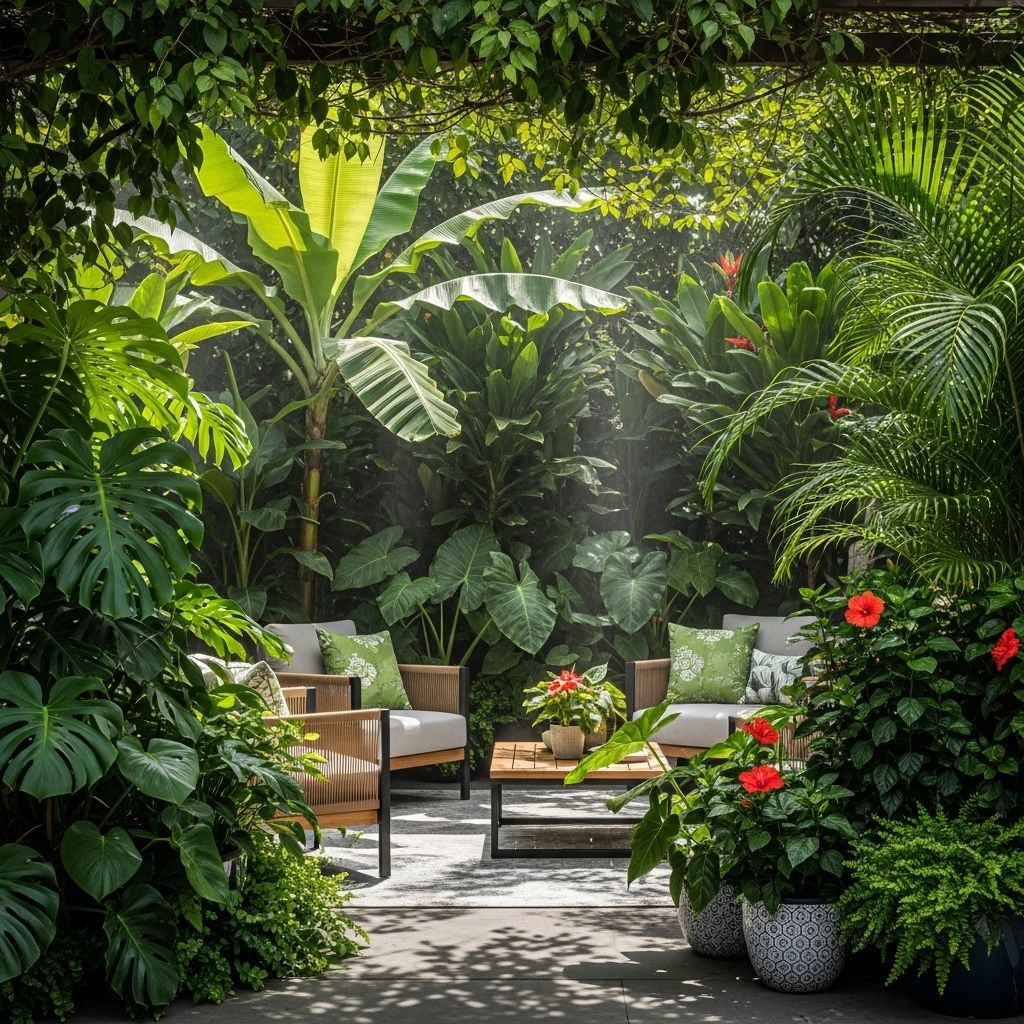Tropical Plants: Transforming Homes & Gardens with Lush Jungle Appeal
Bring exotic greenery to life with expert care tips for lush foliage in any room.

Image: HearthJunction Design Team
Tropical Plants: A Field Guide
Tropical plants whisk us to untamed jungles with their oversized, glossy leaves, feathery fronds, and exotic, sometimes surreal, flowers and forms. For gardeners and houseplant enthusiasts, tropicals offer a taste of that wild beauty—no matter the local climate. Whether clustered in an outdoor haven or thriving as living sculpture indoors, these plants promise lushness, vibrancy, and a little drama in any setting.
What Are Tropical Plants?
Tropical plants originate from hot, humid regions—typically in the equatorial zone—where temperatures are consistent, rainfall is plentiful, and frost is virtually unknown. Many of the world’s beloved houseplants and some of the most show-stopping garden specimens hail from these climates.
- Key features: Large, glossy leaves, dramatic shape, vivid coloring, and bold inflorescences.
- Growth habit: From towering trees to trailing vines and groundcover types.
- Preferred conditions: Warmth, high humidity, and protection from frost.
- Common settings: Indoor containers, greenhouses, outdoor gardens in warm zones, and temporary summer displays in cool regions.
Why Choose Tropical Plants?
Embracing tropicals in your plant collection yields a slew of visual and practical benefits:
- Bring instant boldness and structure to design—indoors or out.
- Many varieties are low-maintenance and forgiving as houseplants.
- Offer year-round color and interest, often remaining evergreen.
- Enhance air quality and contribute humidity indoors.
- Provide a sense of escape, relaxation, and connection to nature.
Main Types and Popular Varieties
While the world of tropicals is vast, certain standouts have earned devoted followings among new and seasoned plant lovers. Here are some of the most iconic and reliable genera, plus tips on where and how to use them.
Philodendrons: Lush Simplicity Indoors and Out
Philodendrons are among the most adaptable and popular tropicals kept by enthusiasts. Native to the Americas and the Caribbean, their nearly 500 species span upright nonclimbers and trailing vines. Glossy, often oversized leaves give them an instant dramatic impact. In tropical/subtropical gardens, large varieties become lush focal points; indoors, both forms are easy to maintain and forgiving (they’ll even flourish with the occasional missed watering). [See FAQs below]
- Type: Foliage; perennial.
- USDA Zones: 9–11 (outdoors); anywhere as a houseplant.
- Light: Filtered/indirect.
- Design tip: Cluster several for jungle vibes or let vines liven up shelves and window frames.
Prayer Plants: Living Works of Art
Prayer plants include both the Calathea and Maranta genera, celebrated for their intensely patterned leaves and mesmerizing daily movements—their foliage folds up at night as if in prayer, then unfurls by day. Moisture-loving and best suited for humid environments, these plants thrive in well-lit kitchens and bathrooms, or grouped together where humidity is higher. Their leaves frequently showcase striking patterns in shades of green, purple, pink, and white.
- Native to: Tropical Americas (often dense, swampy forests).
- Growth: Spreading, evergreen, low to ground.
- Status: Perennial; commonly kept as houseplants outside of zone 11+.
- Varieties: Maranta leuconeura erythrophylla (with deep red veins) is especially adored.
- Tips: Avoid direct sunlight and cold drafts; maintain even moisture and high humidity.
Air Plants: The Epiphytes (Tillandsias)
Air plants (Tillandsia spp.) are enchanting, frost-tender epiphytes that demand little in the way of soil—rooting themselves on rocks, tree bark, and even shells in their native habitats. With nearly 600 varieties, they offer a dizzying range of forms and foliage. Their main requirements? Bright, indirect light and regular misting or soaking. They are ideal for creative displays, from wall-mounted arrangements to terrarium centerpieces.
- Native to: Tropical Central and South America.
- Maintenance: Low; just mist or soak weekly.
- Use: Modern, minimalist displays; living art; desk companions.
- Care note: Good air circulation is essential to prevent rot.
Classic Outdoor Tropical Favorites
These bold plants shape the visual essence of a tropical garden in suitable climates—and many can moonlight as temporary summer exotics further north.
- Banana (Musa spp.): Towering leaves create instant drama and shade; look for hardy varieties in zone 8–10.
- Elephant Ear (Colocasia, Alocasia): Massive, architectural foliage; prefers damp/moist soil.
- Hibiscus: Large, colorful blooms; grow as shrubs or trees.
- Windmill Palm (Trachycarpus fortunei): Surprisingly cold-tolerant, with dramatic fan-shaped fronds.
- Caladium: Heart-shaped leaves with dazzling patterns, perfect for brightening shaded spots.
Designing with Tropical Plants
Tropicals excel in creating layered, visually rich environments—whether in an outdoor oasis or as a lush retreat indoors. When planning a tropical-inspired space, consider these strategies:
- Layer heights and textures: Combine upright species, hanging varieties, and ground-huggers.
- Mix foliage shapes and colors: Pair broad-leafed giants with feathery ferns or spiky dracaenas.
- Feature statement plants: Place large specimens (e.g., fiddle-leaf figs, philodendrons) as living sculpture.
- Add personality: Use vibrant glazed pots or woven baskets for an eclectic feel.
- Group for impact: Create vignettes of three or more plants with contrasting textures and sizes.
Outdoor Tropical Gardens
- In warm zones (USDA 9–11): Grow tropicals year-round in the landscape; combine palms, flowering gingers, cannas, and more.
- In temperate zones: Use containers for easy relocation in fall; many tropicals summer outdoors but must come inside before frost.
- Water & humidity: Group plants together to help maintain high humidity naturally.
Indoor Tropical Retreats
- Light: Most prefer bright, indirect sunlight; avoid harsh direct sun which can scorch delicate leaves.
- Humidity: Place on trays of pebbles with water, cluster plants, or run a humidifier in dry climates.
- Companions: Combine large statement plants (e.g., fiddle-leaf fig) with trailing vines and compact ferns for a lively, wild effect.
Essential Care Tips for Tropical Plants
While often considered exotic, many tropicals are surprisingly forgiving when you meet a few basic requirements:
- Consistent warmth—avoid cold drafts and sudden temperature shifts.
- High humidity—mist regularly or employ humidifiers, especially in winter.
- Filtered light—place near east or north windows, or use sheer curtains for bright windows.
- Even moisture—keep soil damp (not soggy), but allow slight drying for robust roots.
- Fertilize lightly—during active growth seasons with a balanced, water-soluble formula.
- Watch for pests—such as spider mites, which thrive in low humidity.
Commonly Asked Questions (FAQs)
Q: Are philodendrons truly low-maintenance, and can they live outdoors?
A: Yes. Philodendrons are known for their resilience and tolerance of infrequent watering. While many are kept as houseplants, in USDA zones 9–11 they make lush garden statements outdoors. In cooler regions, bring them inside before cold weather arrives.
Q: Can tropical plants survive cold climates?
A: True tropicals can’t withstand frost. However, many can be grown outside during warm months, then moved indoors or given protection when temperatures fall. Some, like the windmill palm, are surprisingly cold-hardy for their class.
Q: What’s the difference between Maranta and Calathea prayer plants?
A: Both belong to the Marantaceae family and share similar leaf habits and care needs. Their main differences are subtle and botanical—many gardeners use the common name ‘prayer plant’ for both due to their folding leaf motion and vivid leaf designs.
Q: How do I increase humidity for my indoor tropicals?
A: Grouping plants together, setting pots on pebble trays with water, misting leaves, and using room humidifiers are effective ways to keep humidity high, especially in winter or air-conditioned rooms.
Q: Are air plants (Tillandsia) hard to care for?
A: Not at all! Air plants just need bright, indirect light, weekly misting or soaking, and good air circulation to prevent rot. Their soil-free needs make them ideal for creative indoor displays.
Design Inspiration: Creating Your Own Jungle
There’s no single formula for styling tropicals, but these ideas can set you on your way to a lush, restful paradise:
- Let a fiddle-leaf fig anchor one side of a living room or hallway.
- Fill empty corners with oversized elephant ears or a cluster of palms.
- Add color and movement with caladiums or prayer plants on shelves and tables.
- Encourage trailing vines of philodendrons or pothos to spill from planters, evoking the rainforest canopy.
- Experiment with air plants mounted in driftwood or on walls for a whimsical, modern edge.
Tropical Plant Table: Popular Varieties & Requirements
| Plant | Best Setting | Light | Water | Key Features |
|---|---|---|---|---|
| Philodendron | Indoors / Outdoor beds (zones 9–11) | Filtered | Moist, not soggy | Glossy sweeping leaves, vine/trailing types |
| Prayer Plant (Maranta, Calathea) | Indoors / Patio containers | Indirect | Moist, high humidity | Patterned foliage, night ‘prayer’ movement |
| Air Plant (Tillandsia) | Indoor displays, terrariums | Bright, indirect | Mist / soak weekly | Soil-free, unique forms |
| Elephant Ear | Outdoor beds (warm climates) / Indoors | Shade / filtered | Damp soil | Massive leaves, bold texture |
| Windmill Palm | Outdoor gardens (zone 7+) | Full sun / partial shade | Regular | Cold hardy for a tropical; fan-like fronds |
| Banana | Outdoor gardens (zones 8–11); containers elsewhere | Full sun | Frequent | Dramatic, fast-growing foliage |
Final Thoughts: Bringing the Tropics Home
Whether your aim is an outdoor paradise or a vibrantly green living space, tropical plants reward attention with unsurpassed lushness and color. Select varieties suited to your environment, group thoughtfully, and don’t shy away from bold statements. Your own slice of the jungle—winding vines, sculptural leaves, or clouds of blooms—is closer than you think.
References
- https://www.gardenia.net/guide/tropical-plants-for-your-outdoor-garden
- https://www.gardenista.com/garden-design-101/tropical-plants/philodendron/
- https://www.gardenista.com/garden-design-101/tropical-plants/
- https://www.gardenista.com/posts/gardening-101-prayer-plants-calathea-maranta-houseplants-growing-care-guide/
- https://www.gardenista.com/posts/10-things-nobody-tells-you-about-air-plants-tillandsias/
Read full bio of Anjali Sayee












